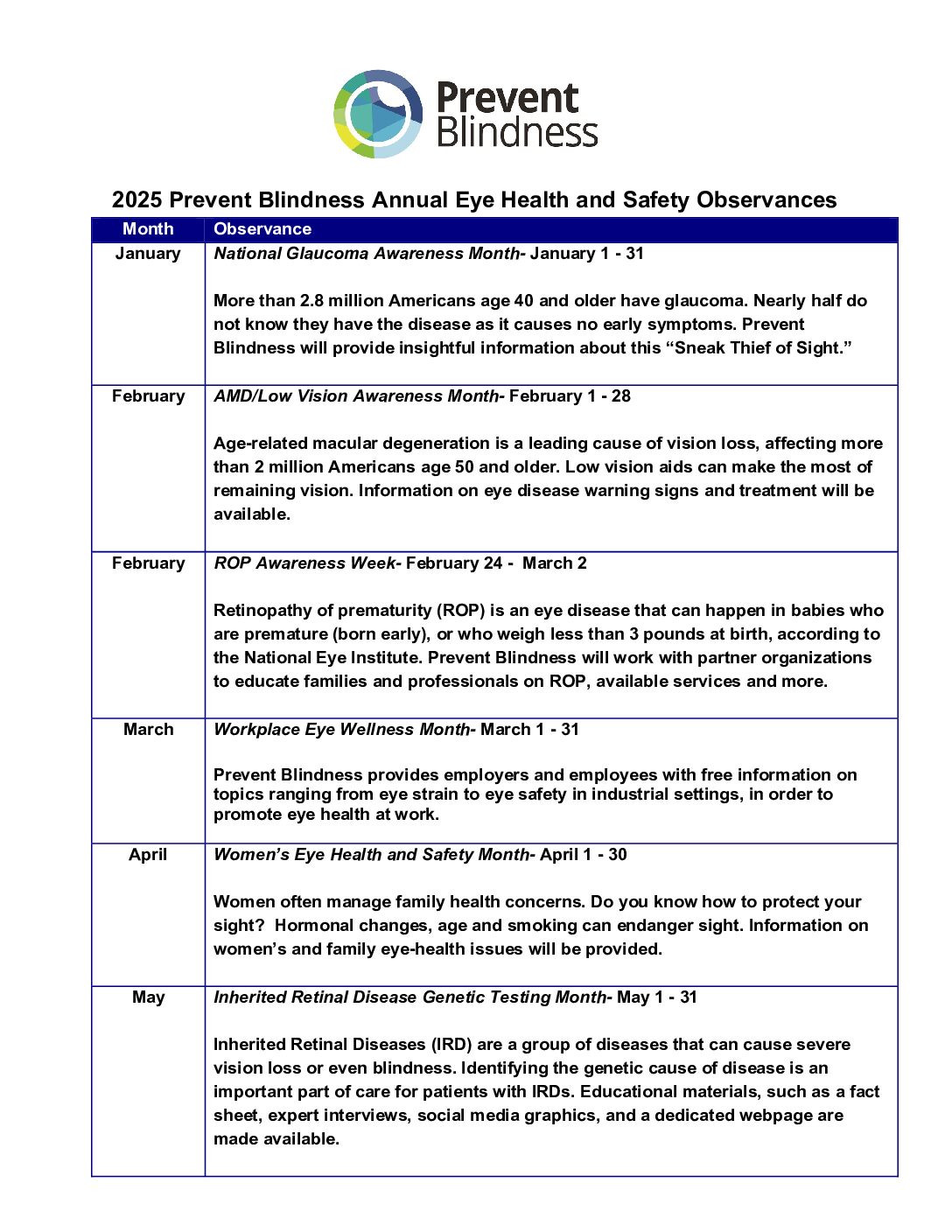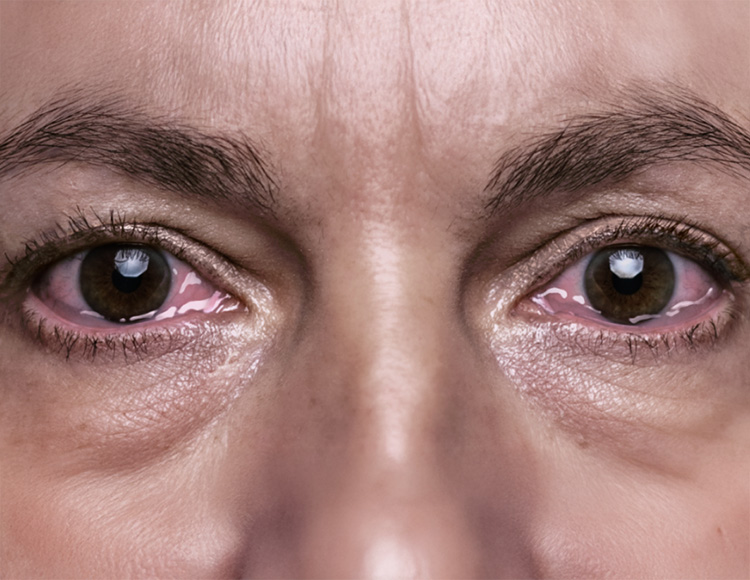Eye Health and Safety Observance Calendar
The Prevent Blindness Annual Eye Health and Safety Observance Calendar highlights key weeks and months throughout the year to promote a wide range of eye health and safety topics. Each month or week features awareness campaigns and educational initiatives on a specific eye health issue such as glaucoma, cataracts, and children’s eye health.
These topics will be emphasized in our social media and media outreach and on our website. The calendar serves as a resource for raising awareness, providing vital information, and encouraging preventive measures to protect vision.
October is Contact Lens Safety Month
Inflammatory Eye Disease (IED) Awareness Week
Diabetes Eye Disease Month
Thyroid Eye Disease Awareness Week
Give the Gift of Sight Month
Geographic Atrophy Week
2025 Observances
Observance Months
Observance Weeks
January
National Glaucoma Awareness Month—January 1-31
More than 2.8 million Americans age 40 and older have glaucoma. Nearly half do not know they have the disease as it causes no early symptoms. Prevent Blindness will provide insightful information about this “Sneak Thief of Sight.”
February
AMD/Low Vision Awareness Month—February 1-28
Age-related macular degeneration is a leading cause of vision loss, affecting more than 2 million Americans age 50 and older. Low vision aids can make the most of remaining vision. Information on eye disease warning signs and treatment will be available.
Retinopathy of Prematurity Awareness Week—February 24-March 2
Retinopathy of prematurity (ROP) is an eye disease that can happen in babies who are premature (born early), or who weigh less than 3 pounds at birth, according to the National Eye Institute. Prevent Blindness will work with partner organizations to educate families and professionals on ROP, available services and more.
March
Workplace Eye Wellness Month—March 1-31
Prevent Blindness provides employers and employees with free information on topics ranging from eye strain to eye safety in industrial settings, in order to promote eye health at work.
April
Women’s Eye Health and Safety Month—April 1-30
Women often manage family health concerns. Do you know how to protect your sight? Hormonal changes, age and smoking can endanger sight. Information on women’s and family eye-health issues will be provided.
May
Inherited Retinal Disease Genetic Testing Month—May 1 – 31
Inherited Retinal Diseases (IRD) are a group of diseases that can cause severe vision loss or even blindness. Identifying the genetic cause of disease is an important part of care for patients with IRDs. Educational materials, such as a fact sheet, expert interviews, social media graphics, and a dedicated webpage are made available.
June
Cataract Awareness Month—June 1-30
Cataract is the leading cause of blindness in the world. And, there are more than 25.7 million Americans age 40 and older with cataracts. More than half of all Americans will have cataracts by age 80. Prevent Blindness will offer tips about prevention, symptoms and information about surgery.
Fireworks Safety Week (June 28-July 4)
Activities during this period will alert parents and children to the dangers of playing with fireworks. Prevent Blindness will offer safer ways to celebrate the Fourth of July.
July
Dry Eye Awareness Month- July 1-31
Nearly 16 million Americans have dry eye, which in severe cases, may cause serious vision problems. Prevent Blindness will provide information on the condition, including symptoms, risk factors, treatment option and more.
Fireworks Safety Week (June 28-July 4)
Activities during this period will alert parents and children to the dangers of playing with fireworks. Prevent Blindness will offer safer ways to celebrate the Fourth of July.
August
Children’s Eye Health and Safety Month—August 1-31
Included in this month will be information about eye conditions such as amblyopia and strabismus. Also included will be tips about preventing eye injuries in children, signs of possible eye problems and general eye health.
September
Sports Eye Safety Month—September 1-30
There are thousands of eye injuries a year related to sports. Tips on how to protect yourself and your children from such eye injuries will be discussed.
October
Contact Lens Safety Month—October 1-31
Approximately 46 million U.S. residents wear contact lenses. Prevent Blindness provides tips and information on how to obtain, use and care for contact lenses safely. Halloween eye safety is also included.
Inflammatory Eye Disease Awareness Week—October 20-26
Information about different types of Inflammatory Eye Diseases (IED) will be provided, including uveitis, keratitis, and thyroid eye disease.
November
Diabetes-related Eye Disease Month—November 1-30
Can people with diabetes prevent the onset of diabetic eye disease? During this observance, Prevent Blindness will offer information to help the more than 8.1 million Americans age 40 and older who have diabetic eye disease.
Thyroid Eye Disease Awareness Week—November 10-16
Thyroid Eye Disease (TED) is an autoimmune disease in which the immune system causes inflammation and swelling and stimulates the production of muscle tissue and fat behind the eye. Prevent Blindness will provide information on TED including symptoms and treatment options.
December
Give the Gift of Sight Month—December 1-31
The Holiday season brings together families, friends and festivities. During the month of December, Prevent Blindness will encourage everyone to reflect on the joys of healthy vision and support sight-saving services.
Geographic Atrophy Awareness Week—December 1-7
Geographic Atrophy (GA) is the advanced form of dry age-related macular degeneration (AMD) which leads to vision loss in the center of one’s vision. Prevent Blindness will provide free information, including a web resource, fact sheets and social media graphic to inform the public of the disease that affects an estimated that 1 million people in the United States.







